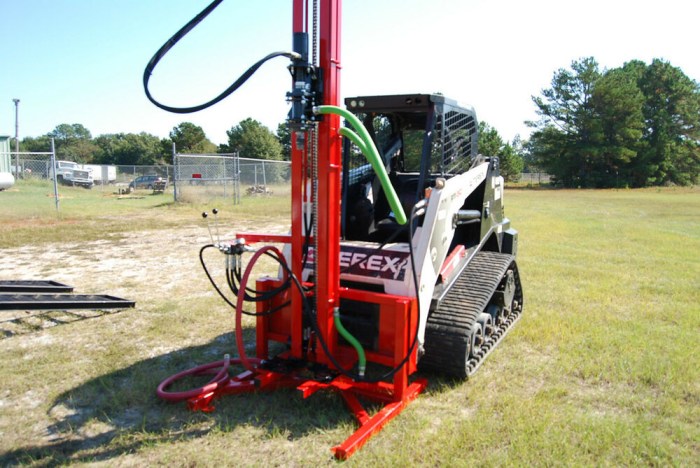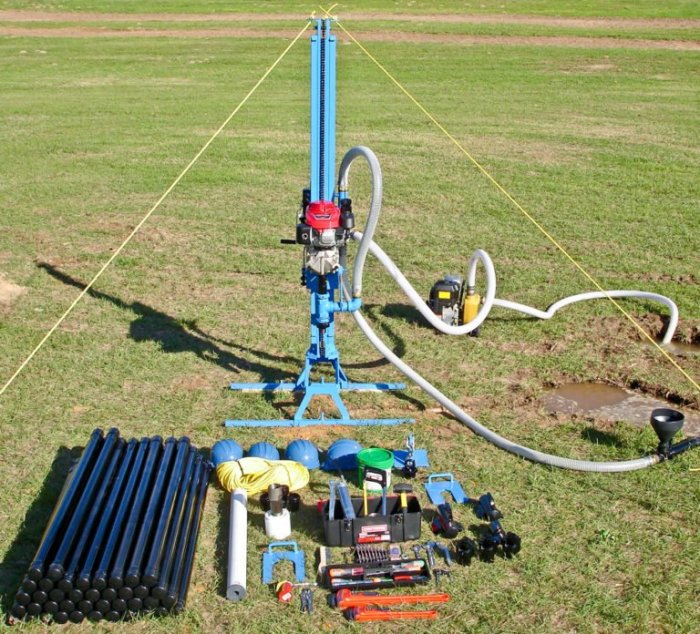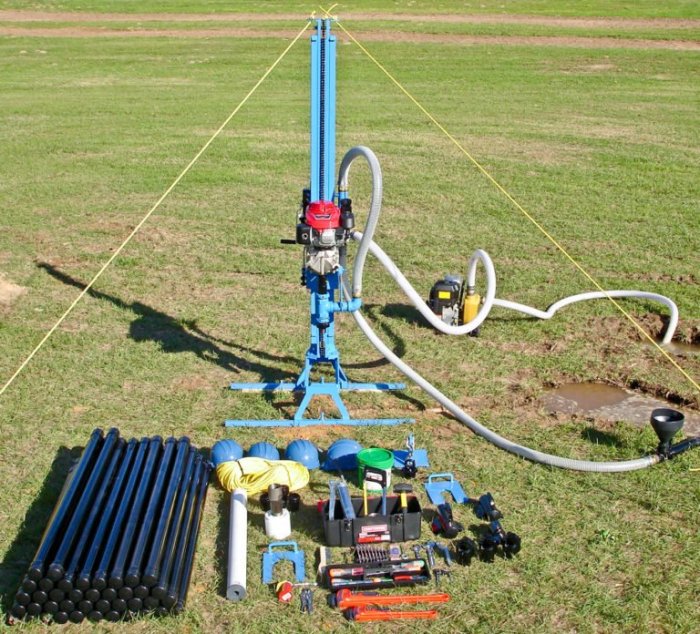DIY Water Well: Imagine having a constant supply of fresh water right in your backyard, a source of life that you can rely on. The idea of drilling your own well may seem daunting, but it can be a rewarding and cost-effective way to achieve water independence. This comprehensive guide will walk you through the process, from planning and preparation to drilling, well construction, and maintenance.
This guide is designed for individuals who are interested in learning about the process of drilling their own water well. It covers the essential steps involved, from planning and preparation to drilling, well construction, and maintenance. We’ll explore the benefits and risks associated with DIY well projects, and provide practical advice and tips to help you make informed decisions.
Introduction to DIY Water Wells

Drilling your own water well can be a rewarding and cost-effective way to access a reliable source of water, especially if you live in a rural area or have a large property. However, it is a complex and potentially dangerous project that requires careful planning, preparation, and execution.
This guide will provide an overview of the process, discuss the benefits and risks involved, and share insights from those who have successfully drilled their own wells.
Benefits of DIY Water Well Drilling
The potential benefits of drilling your own well are numerous and can significantly impact your life and property value.
- Cost Savings: Drilling your own well can be significantly cheaper than relying on a public water supply, especially if you live in a remote area with limited access to municipal water lines.
- Water Independence: Owning a well grants you independence from municipal water systems and their potential rate increases, outages, or restrictions.
- Water Quality: Well water often has fewer impurities and chemicals than municipal water, leading to cleaner, healthier drinking water.
- Environmental Sustainability: By reducing reliance on municipal water systems, you contribute to a more sustainable water usage model.
Risks of DIY Water Well Drilling
While DIY well drilling offers potential advantages, it is essential to acknowledge the inherent risks and challenges involved.
- Safety Concerns: Drilling equipment can be heavy and dangerous to operate. Inadequate safety precautions can lead to serious injuries or accidents.
- Technical Complexity: Well drilling requires specialized knowledge and skills. Improper drilling techniques can damage equipment, contaminate groundwater, or lead to a dry well.
- Legal and Regulatory Compliance: Drilling a well often requires permits and inspections from local authorities. Failure to comply with regulations can result in fines or legal action.
- Environmental Impact: Improper well drilling practices can contaminate groundwater, harming the environment and potentially affecting nearby wells.
Success Story: A DIY Well Drilling Experience, Diy water well
“We decided to drill our own well after our neighbor successfully did it a few years ago. We researched the process, rented the equipment, and spent a few weekends learning the ropes. It wasn’t easy, but it was incredibly rewarding. We now have a reliable source of clean water, and we saved thousands of dollars compared to hiring a professional. We’re glad we took the challenge and learned a lot along the way.” – John S., homeowner.
Planning Your DIY Water Well Project
Before you start digging, it’s crucial to plan your DIY water well project meticulously. This includes understanding the regulations, choosing the right location, and designing a well system that meets your needs.
Understanding Local Regulations and Permits
It’s vital to research and comply with local regulations and obtain the necessary permits before drilling a well. These regulations vary depending on your location and are designed to protect public health and groundwater resources.
For example, in some areas, you might need a permit to drill a well, while others may require you to have your well inspected and tested.
Choosing the Right Well Location
Selecting the right well location is essential for ensuring a reliable and safe water supply. Here are some factors to consider:
- Proximity to Existing Structures: Ensure the well location is a safe distance from septic systems, sewage lines, and other potential contamination sources. This distance will vary depending on local regulations and soil conditions.
- Soil Conditions: Conduct a soil test to determine the type of soil and the depth of the water table. Different soil types have varying water holding capacities and may require different drilling techniques.
- Potential Contamination Sources: Consider the presence of potential contamination sources like agricultural runoff, industrial waste, or landfills. These sources can contaminate groundwater and affect the quality of your water.
Designing a Basic Well System Layout
A well system typically consists of several components, including the well itself, a pump, a storage tank, and piping. Here’s a basic layout:
- Well: The well is the vertical shaft drilled into the ground to access groundwater. The depth and diameter of the well will depend on your water needs and the depth of the water table.
- Pump: The pump is used to draw water from the well and deliver it to the storage tank. The pump’s capacity should be sufficient to meet your water demands.
- Storage Tank: The storage tank holds the water pumped from the well and provides a reserve for use. The size of the tank will depend on your water usage patterns.
- Piping: Piping connects the well, pump, and storage tank, transporting water throughout the system. The piping material should be durable and resistant to corrosion.
Essential Tools and Equipment

Drilling a well is a complex and demanding task, requiring specialized tools and equipment. You must have the right tools to ensure safety and success in your DIY well project. This section will discuss the essential tools and equipment needed for drilling a well, including a drilling rig, drilling rods, casing, and a well pump.
Drilling Rigs
Drilling rigs are the heart of any well-drilling operation, providing the power and mechanism to bore into the earth. Several types of drilling rigs are available, each with its own advantages and disadvantages.
- Cable-Tool Rigs: These rigs use a heavy cable to lift and drop a drill bit, creating a percussive action to break through rock. They are relatively simple and affordable but require a significant amount of manual labor. They are suitable for shallow wells in soft to moderately hard formations.
- Rotary Rigs: Rotary rigs use a rotating drill bit attached to a drill pipe. They are more powerful and efficient than cable-tool rigs, allowing for deeper wells in harder formations. Rotary rigs are commonly used for commercial well drilling.
- Auger Rigs: Auger rigs use a rotating auger to drill into the earth. They are primarily used for shallow wells in soft ground, such as clay or sand. They are relatively inexpensive and easy to operate.
Drilling Rods
Drilling rods, also known as drill pipes, connect the drill bit to the drilling rig. They are typically made of steel and come in various lengths. The number of rods used depends on the depth of the well. They are essential for transmitting the rotational force from the rig to the drill bit.
Casing
Casing is a protective pipe inserted into the wellbore to prevent collapse and contamination. It is typically made of steel or PVC and comes in various diameters. Casing helps to maintain the integrity of the well and protect the groundwater from contamination.
Well Pump
A well pump is essential for drawing water from the well and delivering it to your home. Several types of well pumps are available, including:
- Submersible Pumps: Submersible pumps are placed at the bottom of the well, submerged in water. They are highly efficient and quiet but can be expensive to install.
- Jet Pumps: Jet pumps are located above the well, using a venturi effect to draw water from the well. They are less expensive than submersible pumps but are less efficient and louder.
Safety Precautions
Safety should be your top priority when operating drilling equipment. Here are some essential safety precautions:
- Proper Training: Ensure that you are adequately trained on the operation and maintenance of the drilling equipment before using it.
- Personal Protective Equipment (PPE): Always wear appropriate PPE, including safety glasses, gloves, hard hats, and steel-toe boots.
- Inspect Equipment Regularly: Inspect the drilling rig and all related equipment before each use.
- Clear the Work Area: Ensure that the work area is clear of any obstacles or hazards.
- Follow Manufacturer’s Instructions: Always follow the manufacturer’s instructions for operating and maintaining the equipment.
- Never Operate Equipment Under the Influence of Alcohol or Drugs:
- Be Aware of Your Surroundings: Be aware of your surroundings and any potential hazards.
Drilling your own water well can be a challenging but ultimately rewarding project. By following the steps Artikeld in this guide, you can increase your chances of success and ensure a safe and reliable water source for your home or property. Remember to prioritize safety, comply with local regulations, and consult with professionals when necessary. With careful planning and execution, you can achieve the goal of water independence and enjoy the benefits of having your own well for years to come.
Building a DIY water well can be a rewarding project, but it’s important to do your research and ensure you have the necessary permits. Once you’ve tackled that, you might find yourself ready for another DIY challenge, like installing plantation shutters diy to add a touch of elegance to your home. Just remember, while both projects require some skill and patience, the satisfaction of creating something yourself is truly priceless.

